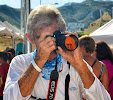
Brad Erisman of Scripps Institution of Oceanography at UC San Diego (left) and Ralph Chaney of iTV aboard DeepSee submersible during their 2008 expedition to Gulf of California. photo; Octavio Aburto-Oropeza, Scripps Institution of Oceanography at UC San Diego
Last year Scripps Institution of Oceanography at UC San Diego and San Diego Natural History Museum partnered a series of underwater expeditions in the Sea of Cortez using a DeepSee submarine, reminiscent of Jules Verne’s visions when he authored his classic science fiction novel, Twenty Thousand Leagues under the Sea, in 1870.
Captain Nemo would have been right at home in this state-of-the-art custom built one-atmosphere submarine, capable of carrying one pilot and two passengers down to a depth of 1,500 feet. The crystal clear four inches thick sphere literally disappears when submerged. It provides the occupants an unparalleled and unobstructed 360 degree view of the undersea world. DeepSee was designed to allow its passengers to board and disembark the sub while it is floating alongside a mother ship. Decompression isn’t necessary.
One expedition included researchers Exequiel Ezcurra (adjunct professor at Scripps Oceanography and former provost of the San Diego Natural History Museum), Brad Erisman (Scripps postdoctoral researcher), and Octavio Aburto-Oropeza (graduate student researcher). They used the three-person DeepSee to explore marine life in the Gulf of California's deep sea reefs and around undersea seamounts. The vehicle allowed the researchers unique access to depths below 164 feet which is generally inaccessible to SCUBA divers. The results were revealing, yielding some of the Sea of Cortez’s deep sea secrets.
"Our investigation resulted in many new discoveries which included new species of invertebrates and possibly fishes," said Erisman. "We collected and observed species that had not been recorded in the gulf, had never been observed alive or had never been observed at such depths."
The exploration at depths formally inaccessible also yielded evidence of disturbing declines in sea life populations caused by human impact. Large schools of fish documented in earlier expeditions at locations such as the El Bajo seamount have vanished.
"The human impacts in shallow areas have been well documented, but our observations make it clear that we are reaching down deeper and affecting the deeper ecosystems and their communities as well," said Aburto-Oropeza. "We have lots of evidence of ghost nets with trapped animals at many depths, along with pollution, including beer cans, in each deep location we studied."
As the researchers ventured farther offshore to Las Animas, a seamount tucked halfway between Loreto and La Paz, (an area that has little impact from fishing, boating and human activities), they found encouraging booming fish populations, an extraordinarily rich variety of red snapper, unique shrimp and possibly new species of sea urchins and cucumbers.
On another trip in October, Erisman and Aburto-Oropeza studied marine life at Cabo Pulmo, a protected national park near the southern tip of the Baja peninsula. In the absence of human environmental pressures, like Los Animas farther to the north, they recorded a "biodiversity hotspot" with thriving fish populations and a rich mix of sea life. They even witnessed large tiger sharks, now a rarity in Baja California. According to Erisman and Aburto-Oropeza, "Cabo Pulmo, demonstrates that if the areas are protected over time they can rebound to a previous healthier ecosystem state." World-renowned marine biologist, Bill Boyce recently wrote, “If Cabo Pulmo Marine Park wasn’t protected, it would be a biological desert, over fished, and then over looked.”
Off the beaten track Los Animas and Cabo Pulmo are living proof that there is still time to implement conservation and management practices that will restore healthy marine-life populations. Hopefully, this added to growing body of evidence will influence the Mexican Government to pursue more aggressive conservation efforts.



